What is kombucha? Good question? Here are the kombucha basics, including what it is, how it’s made, and how you can make it at home!

Yes, friends, we will be dedicating this entire week (+ more, who knows) to the fermented tea that is kombucha. It’s not necessarily an ingredient per se, but the world of kombucha brewing is vast and fizzy and delicious and not complicated once you get the hang of it. So let’s get the hang of it.
I first experienced kombucha a few summers back while visiting the little sis on Maui. My general routine for two blissful weeks included stopping by one of the local hippie groceries each morning, picking up a bottle of strawberry chia seed kombucha, and setting up my hammock between two palm trees to lay and enjoy my tasty elixir. Ever since, kombucha has been my instant Hawaii flashback, which is why I can convince myself that paying $4 for a small bottle of it is okay…every time I go to the grocery.
But $4 for a bottle of kombucha is not okay. For a fraction of the price (like ⅛ the price) you can brew better kombucha at home. Yes, better. So this post today will just be an overview of the vast kombucha world, and in a few days we’ll jump into the process, start to finish. Sound good?
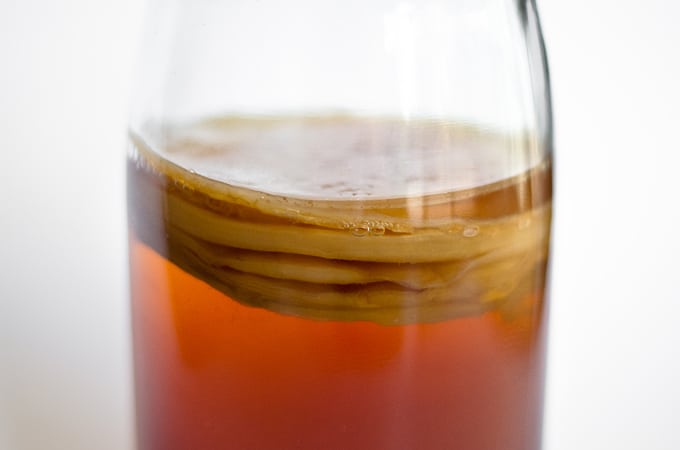
What is kombucha?
What is kombucha? Great question! Kombucha is a carbonated drink created by fermenting sugar + tea + starter tea + a SCOBY.
The SCOBY (symbiotic culture of bacteria and yeast), also known as the “mother”, is a thick, rubbery, pancake of sorts that rests on the surface of the brew, growing with each batch. The bacteria and yeast in the SCOBY and starter tea encourage the fermentation.
What is fermentation?
And what exactly is fermentation? It’s basically just the process of bacteria and yeast eating up sugar to produce acids, gasses, or alcohol. In the case of kombucha, we’re getting a bit of each. While the most notable byproduct of the kombucha fermentation process is the fizzy effervescence from the release of gasses, the beverage also has an acidic, mildly vinegar taste, as well as trace amounts of alcohol.
How is kombucha made?
If you’re starting completely from scratch, there are three general steps in the kombucha making process. We dive into the process of how to make kombucha here, but the general process goes something like this:
- Make your SCOBY (1 to 4 weeks): You’ll put this all into a big glass or ceramic container, cover it with a cloth so no bugs come stealing your juice, and forget about it.
- First Fermentation (about 1 week): Again, you’ll cover it, put it in a cupboard, and let it do its thing. The longer it ferments, the more the sugars are eaten by the bacteria and yeast, the more acidic it becomes…this part is just a tasty balancing act.
- Second Fermentation (2 to 5 days): You’ll remove the SCOBY and strain out the floaties from your first fermentation, pour the fermented tea into bottles, add a touch of sweetener for the bacteria and yeast to feed on, and seal tightly with a lid. This is the anaerobic (no oxygen) step, meaning more alcohols and acids are formed. The tight seal also prevents carbon dioxide from escaping, and thus the tea becomes carbonated.
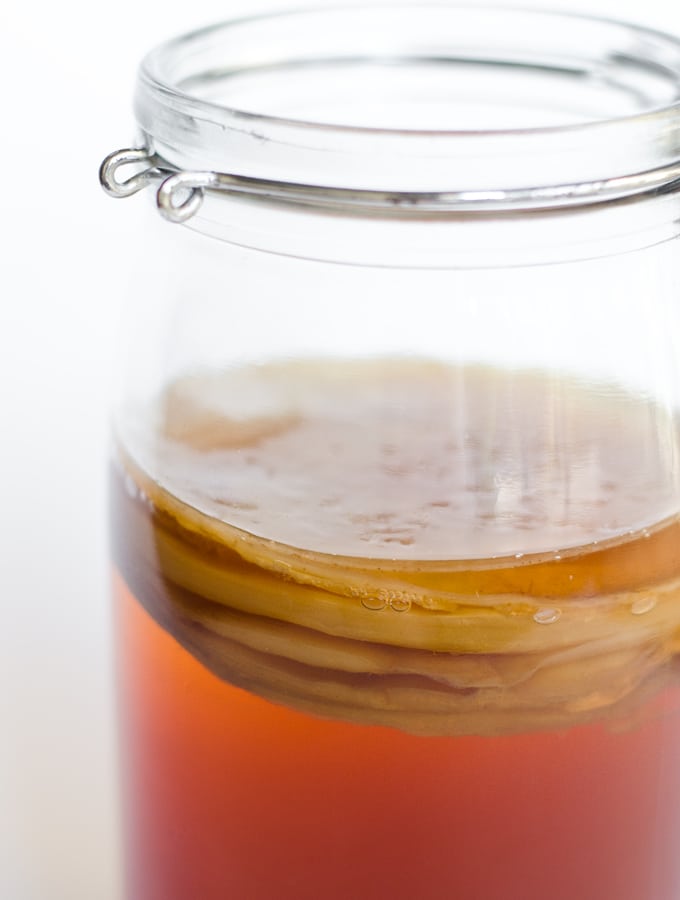
The history of kombucha
I love researching the history of foods and cuisines, and I was so excited to serve you up some riveting kombucha history today….but….there appears to be just about zilch. It looks like kombucha brewing probably began in 250-ish BC China, then made it’s way around Japan and Russia and there was mention of a Korean guy named Kombu and eventually it crept into Germany and finally to America in the 1990s. So let’s just call it…**Kombucha, the timeless drink that unites us all** 🙂
What are the benefits of kombucha?
Probiotics: You know all those bacteria we’ve been talking about? Yea, they’re really good for your gut. Your gastrointestinal tract contains millions (of trillions of gazillions) of bacteria that play a role in everything from your immune system to your digestion and even to your weight. Sometimes the number of these good bacteria can dwindle, either because antibiotic use or the invasion of a bad bug (hello, Moroccan giardia) or just everyday, 21st century life. Consuming foods and drinks rich in the probiotics can help to keep your microbiome balanced and strong.
It’s an awesome soda substitute: The fizzy carbonation and moderate caffeination of kombucha makes it a great substitute for those looking to cut soda. The diet soda addicts can rest assured knowing that they can replace aspartame and non-caloric sweeteners (possible disrupters of the microbiome) with an equally delicious yet quadruple-y probiotic-y counterpart. And for the sugary soda lovers, how’s about some simple math. If you swap just one 8 oz soda per day with 8 oz of kombucha, that’s a difference of 110 calories…over a month that’s 1 lb! And that’s without missing out on caffeine, fizziness, or flavor. Woohoo!
Liver Lover: Bottled kombucha lists 10 mg of glucuronic acid as an ingredient. Glucuronic acid is a liver compound that binds to toxic substances (drugs, alcohols, just bad things in general) so they can be excreted. While your liver does make this compound naturally, it’s possible that kombucha could give it a boost…but the jury is still out on this one.
Kombucha Nutrition Information
per 8 oz (240 mL) of traditional kombucha
- Calories: 30
- Carbohydrates: 7g
- Protein: 0g
- Fat: 0g
- 25% Daily Value (DV) of Folate (Vitamin B9): A water-soluble vitamin that helps make DNA & RNA and metabolize amino acids.
- 20% DV of Vitamin B12 (Cobalamin): A water-soluble vitamin important in brain and nervous system function as well as red blood cell formation. It is only found naturally in meat and animal products, but can be made via bacterial fermentation.
- 20% DV of Vitamins B1, B2, B3, and B6: water-soluble vitamins that play varying roles in energy metabolism.

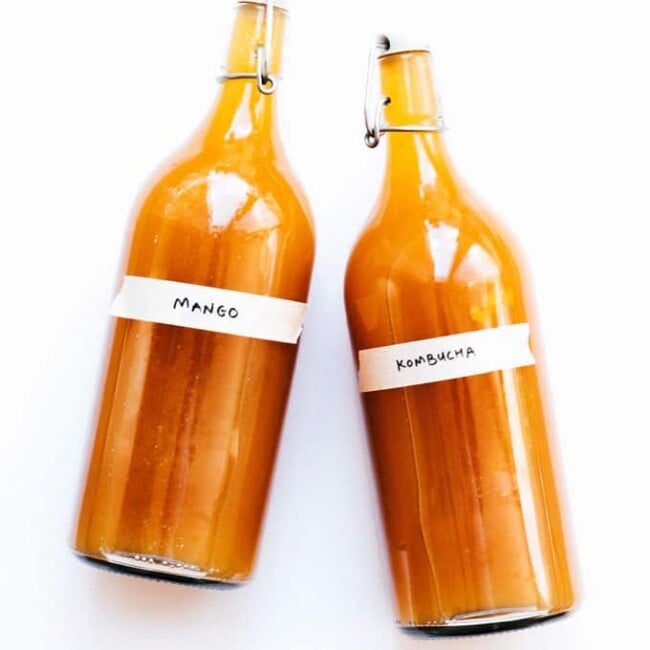
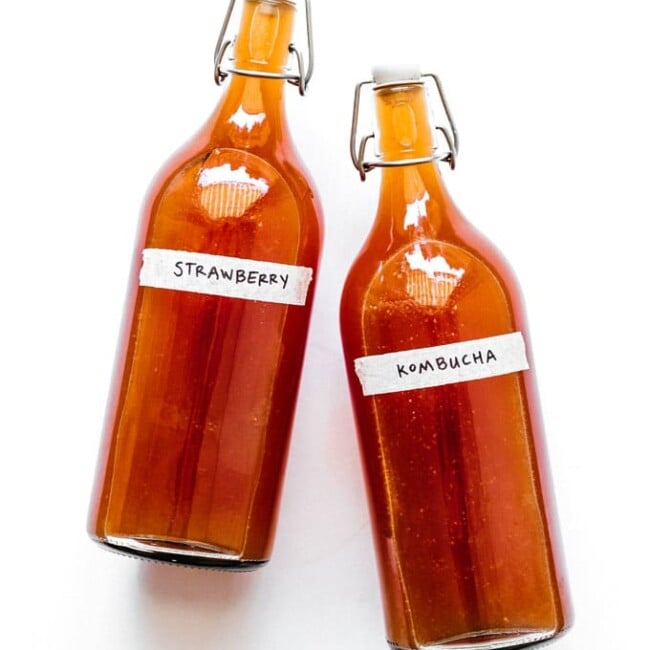
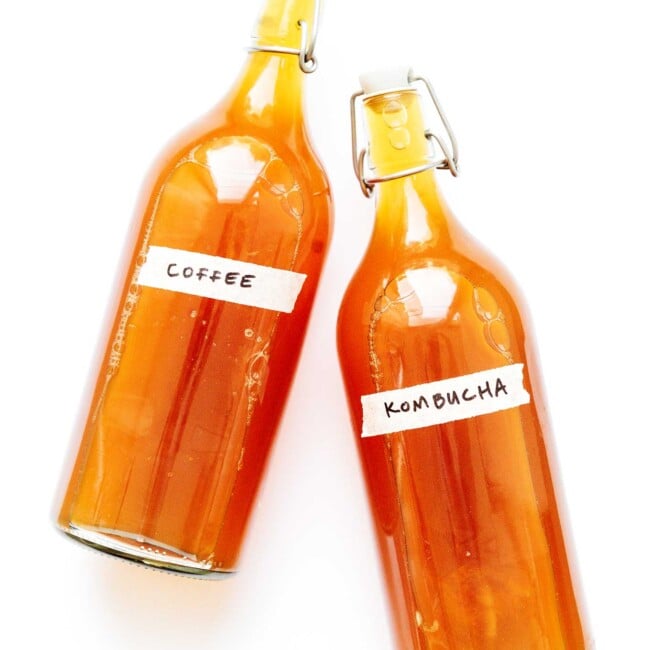
Kristin says
Does kombutcha brewed with black tea retain its caffeine? My little kids would love to drink it at every meal but this question give me pause. Thanks for any input and for the great article.
Sarah says
Great question, Kristin! Kombucha has about 1/3 of the amount of caffeine than the tea it was made with. So a black tea with 30 mg caffeine would make a kombucha with 10 mg. This article has a few tips on how to make less-caffeinate kombucha if you’re interested!
Pamela says
Any brand I can get to start the mother?
Sarah says
Hi Pamela! I haven’t tried buying a mother before, but I have instructions on how to easily make a SCOBY mother here: http://www.liveeatlearn.com/the-simple-guide-to-kickass-kombucha/. I like to use GT Kombucha (plain) to start the brewing process (because you need a starter)
Sharon Curtis says
Should the mother scobi be peeled of layers periodically? And if so, peeled from the top or bottom?
Sarah says
Hi Sharon! Great question, and yes! You’ll want to separate the SCOBY when it becomes over an inch thick. The bottom (closest to the tea) will be the oldest, and that is the one you should remove (though it is still strong enough to start a new batch/give to a friend!)
Enrique Pasion says
Since I have been approaching an age where one need’s to take care of his/her health, I have been looking for alternatives to food and drinks I used to take younger.
Kombucha looks to be a promising alternative drink to those unhealthy ones like soda and, in a way, coffee. Thank you for this article.
Stephanie says
OK – is there any way to make this without sugar, or less sugar or stevia?
Sarah says
Hi Stephanie! This is one of few recipes where you really cannot use sugar substitutes. BUT you won’t actually be consuming that whole 1 cup of sugar. The sugar is food for the bacteria and yeast. They’ll basically eat it all up and produce wonderful things like acidity and carbonation, and the finished kombucha will be much lower in sugar as a result.
Carol Pina says
Can you use a few cups of you previous fermentation to make your next one. I know this is done for the send fermentation. I’m on my 4th fermentation using a few cups from my previous. Is this ok to continue?
Sarah says
Yes you just continue that (forever!) It freshens up a bit every time by you adding new tea. But there will always be a liiiitle bit of that first tea in there (a bit like generations old sourdough starter or friendship bread!)
MAUREEN HIPWOOD says
Hi Sarah. Is it possible to suspend the Kombucha making process and preserve the SCOBY. We will be going away for 3-5 weeks soon and I would like to continue making the Kombucha on our return.
I have only made 3 batches so far but each one seems to get better. Thanks so much for such great instructions.
Maureen
Sarah says
Hi Maureen! If you give your SCOBY a batch of fresh tea right before you go and set it in a relatively cool part of your house, 3 to 5 weeks shouldn’t be a problem. The tea won’t be drinkable when you get back, but the SCOBY should be just fine! 😀
Maggie says
Great article! Can I use a metal straw to insert into the Kombucha for tasting?
Sarah says
Brief contact with metal is fine, so a metal straw shouldn’t be a problem 😀
Kelly says
Kombucha: Brilliant post Sarah, thank you.
I have a question that my holistic dentist put into my head… carbonated drinks (even carbonated water) create an acidic environment in the mouth which is detrimental to teeth. Is there benefit to carbonating kombucha or is it just a texture thing?
Do you by any chance know is it any less acidic if it isn’t carbonated?
Thank you
Sarah says
Hi Kelly! The carbonation is mainly for that bubbly, refreshing feel (all the probiotic building healthiness is done in the first ferm, so health wise you could drink first ferm kombucha and get the same health benefits). I’m honestly not sure if it would be less acidic by not carbonating it. There are some pretty cheap pH indicators you can buy if you’re interested in getting a firm answer! 😀
Ilene says
Hi Sarah. I can’t find your article about healthy scoby’s. Please can you send me a link. I’ve been brewing for a while and love it, but now my scoby all of a sudden has a brown spot on the side and it looks thin and unhealthy. I once browsed your post about healthy scoby’s, but I wasn’t worried then, so can’t remember if I saw a pic of what my scoby looks like now.
Thanks
Ilene
Sarah says
I think this may be the one you’re talking about! Brown spots and different thicknesses are totally normal, just so long as there isn’t fuzz or dryness.
Vivi says
Hi Sarah! Can i drink kombucha from first fermentations only? Thanks for your guide btw, really useful
Sarah says
Yep, you can drink it straight from the first ferm! 😀
Lesley Kelly says
Hi Sarah, my Kombuch is very cloudy and vinegary… do i have to get rid??
Sarah says
Nope this is normal! Just regular kombucha yeast!
Raj N says
Hi Sarah
I was sick for a while and my scoby went dry. I still tried to make a batch. It has a mouldy top, mostly whitish. Should I throw it away?
Sarah Bond says
Hi Raj! Unfortunately yes, if there’s mold then you should throw it out to prevent it from contaminating further batches.
TechUnadept says
I made my first batch of tea really, r e a l l y strong (I took “boil 10 bags of black tea for ten minutes” to mean “hold your tea at a rollicking boil for ten minutes,” which I find out almost a week later is apparently the recipie for a cuppa rivalling some illicit drugs) and put in less sugar than I apparently should’ve (1 cup instead of 1.5). Is it ruined? If so, is it possible to fix it?
Sarah Bond says
I don’t think that would ruin it! Give it a taste in a few days 😀
Abigail katherine says
My Mom says that Kombucha can be bad for you in certain areas if you make it wrong. Can you give me some information on that? More specifically she said it can give you a stomach ache, which I can understand.
Sarah Bond says
It can cause some side effects, which we go into in depth in this article about kombucha side effects 😀
Susan says
Great article! Recently, I tried kombucha for the first time, which I ordered from this website, and I’m delighted. I have one small question, can I drink kombucha straight from the first fermentation?
Sarah Bond says
Yes you can!
lim saw looi says
hi,is it acidic or alkaline base?how much can you consume daily?does it provide good bacteria to the gut?thank you
Sarah Bond says
Acidic! Here’s info on how much to consume daily and benefits of kombucha (both on my sister site, Brew Buch).